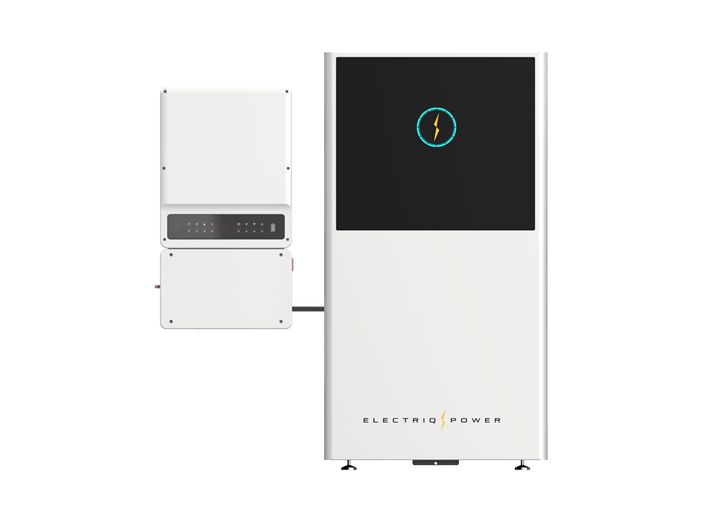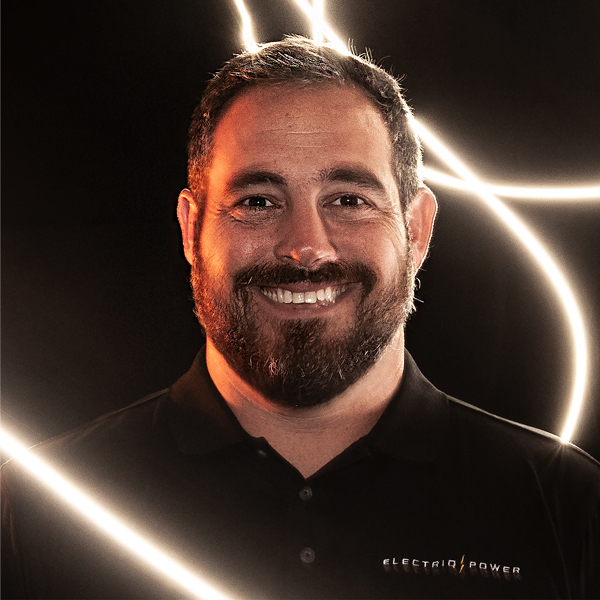One of the most recent developments in the industry is the shift to LFP chemistry, a non-toxic, non-hazardous solution that allows for longer battery cycle life, increased reliability, and enhanced safety. We knew we had to create our own LFP option.
 Covid-19 & Looking Ahead to 2021 and Beyond, Insights From Electriq Power
Covid-19 & Looking Ahead to 2021 and Beyond, Insights From Electriq Power

Q&A with Aric Saunders EVP of Sales and Marketing | Electriq Power
Tell us about yourself and your company.
Electriq Power is an energy storage solutions company based in California that designs, engineers, and assembles fully integrated energy management and storage solutions for homes and small businesses, delivered and deployed by a network of installers across North America.
The company was founded in a garage starting with two totaled Nissan Leaf cars. Originally, we were looking at creating superchargers using old or abandoned EV batteries. Like many startups, we pivoted, moving into the residential energy storage market after a few months, still hoping to use recycled batteries. However, at the time, there was very little cost advantage to taking old batteries and refurbishing them to meet the demands of a residential stationary battery versus an EV battery. Since late 2014, we’ve been laser-focused on creating the best residential energy storage solution through advanced hardware and best-in-class software.
Our early days of tinkering with different inverters and batteries have led us down a path of identifying the best hardware technology on the market while utilizing our software and firmware capabilities. By maximizing value and enhancing user experience, we are able to offer a solution that not only benefits the homeowner, but the utility and grid as a whole.
How has COVID-19 changed the way your company does business?
We’ve had to adjust the way we operate on a day-to-day basis, but it has also driven us to be innovative in our approach to the market. We focused on developing online content, webinars, and tools to help our customers, installers, and distributors learn more about our product remotely. Deliveries, installations, sales calls, and internal meetings were put on hold when the shelter-in-place orders hit, allowing us time to focus on developing these tools. In a matter of a few weeks, we created a webinar series and built out our Youtube channel with educational videos for customers. Although things slowed down in Q2, we had our most profitable months and quarters in 2020, making it our best year to date. This past year has brought to light the fragility of the world we live in. As we move forward into 2021, increasing the resiliency of a person’s home has become a top priority, especially as we see work-from-home protocols extending and, for many, becoming a part of the “new normal.”
There are still things to work through, such as permitting, that have slowed down due to the pandemic. However, we’re seeing AHJs (Authorities Having Jurisdiction) that have been very slow to adopt technology shifting to remote inspections or online permit applications versus pre-pandemic. The sales process has also been hampered, since salespeople can’t sit at the kitchen table with customers anymore. But again, the firms that innovate are the ones that will thrive. Ultimately, we’re energized and encouraged by the way the industry has responded and the innovation that has been spurred on by this generational health crisis.
Have your growth and investment plans changed in the wake of COVID-19?
Yes - not only has COVID-19 shifted the way we operate, our home state has also suffered from massive wildfires. This has shed light onto a growing issue for homeowners: energy independence. The Public Safety Power Shutoffs (PSPS) brought the reality of the current climate situation into the home of every Californian. There are two overarching issues at play here: One, fire season is getting worse every year—the climate is changing and we’re feeling the direct impact. And two, the centralized grid design is antiquated, and despite one of the most progressive policies on solar and storage, utilities are still moving very slowly to a distributed grid. Instead of having a grid that is stable and reliable, we have a grid that causes two million people to lose power when winds are high in one area.
PSPS has caused a rapid increase in deployments at a time when the industry is already facing not only a labor shortage but also a spike in demand for solar due to the potential step-down in the federal ITC incentive. We’re not complaining, but it has created demand that can outpace supply and availability of qualified installers.
One example of this demand occurred in July when $270 million was released for the Self-Generation Incentive Program, just in PG&E territory. This money was originally intended to fund projects for the next four years, but the funds were officially depleted after just two months. All of this occurred during a pandemic. People are losing faith in the grid being available and reliable for the foreseeable future and are taking steps to secure their homes with energy storage systems.
During this pandemic share with us some of the new products and services your company has introduced and how you were able to continue to innovate under the circumstances.
Electriq Power is focused on continuously bringing innovative energy storage solutions to market. The industry is still young and constantly evolving to meet the emerging demands of the marketplace. Our business model does not tie us to any one battery supplier, putting us in a unique position to improve our product more rapidly than our competitors.
One of the most recent developments in the industry is the shift to LFP chemistry, a non-toxic, non-hazardous solution that allows for longer battery cycle life, increased reliability, and enhanced safety. We knew we had to create our own LFP option, but the challenge was finding an affordable solution. We conducted a global search, negotiated with dozens of suppliers, and ultimately ended up with a phenomenal battery from one of the largest and most bankable LFP battery providers in the world.
Additionally, this past October, the PowerPod became the first fully integrated OpenADR 2.0b-certified residential battery storage system on the market, enabling Electriq Power to seamlessly partner with energy aggregators and participate in today’s dynamic energy marketplace.
It’s commitment like this that sets us apart and enables us to offer one of the most capable, feature-rich residential battery systems on the market.
We have made several other improvements in the PowerPod 2 to benefit both installers and homeowners:
- More power: 11.4 kW DC solar, 7.6 kW continuous backup output
- Storage durations from 10 to 20 kWh
- Outdoor-rated (NEMA 3R)
- AC-Coupled option with three models of usable capacity—AC-10 (kWh), AC-15 (kWh), and AC-20 (kWh)
- Grid services-ready through OpenADR 2.0b certification or Electriq-developed PowerADR protocol
- Resilient communication during power and internet outages via built-in, battery-powered LTE
- Modular and easy to install, plus guaranteed commissioning during installation with LTE
Although our business goals and model were challenged during 2020, we still managed to make significant strides in growing the company. In September, we announced definitive agreements with Emergent Microgrid, a provider of turnkey microgrids, and with Lilypad Energy, a provider of data analytics solutions. Emergent Microgrid brings both the value of their existing portfolio and their expertise and knowledge in the microgrid market, giving us a pathway forward into deployment and control of our systems while maximizing the value for microgrids. Additionally, as we continue to build out our vision of increasing value-added services for Virtual Power Plants, our agreement with Lilypad Energy will enable accelerated deployments of battery systems and a foundation from which to provide real-time grid services to support utility infrastructure and grid operators across the country.
What are the biggest challenges facing the solar industry today?
Educating customers on all the benefits available from a battery system is a tougher challenge than understanding how solar provides value. Because everyone knows how much their electric bill is and can calculate solar costs and kilowatt/hour generation, solar benefits and ROI are easier to conceptualize. Batteries can help with monthly bill savings with Time-of-Use rate tariffs, but today, a larger portion of the value is more subjective. For example, the value of resiliency and energy security is different for every person, even within the same household.
On top of monthly bill savings and backup power, grid service programs are being developed in which the utility pays for the opportunity to use your battery when you aren’t. Within grid services, there will be opportunities to not only send surplus power to the grid, but also to take on excess power during the day at a point when electricity may be even cheaper. Many of these programs are being piloted right now and won’t be live for a couple of years, but the value is intrinsic to the system. The way we see it, every year the value of a battery system will actually be increasing as more incentive programs are launched.
The other considerable challenge is the inconsistency in permitting across jurisdictions. Many AHJ entities, especially in growing markets, have never installed a battery and set unrealistic demands for the siting and installation of systems. These demands slow deployments and installations drastically and ultimately deter homeowners from taking on the projects.
What has you optimistic about Renewable Energy in 2021 and beyond?
The pandemic has been incredibly damaging to the economy, however, energy storage and renewable energy have continued to grow rapidly. We’ve seen eight straight quarters of growth even during the pandemic. In fact, 2020’s second quarter set a record for the most residential energy storage systems deployed in the country. The industry surpassed the $1 billion mark in revenue this year.
Despite these great numbers, most systems are located in only a few markets, mainly California, Hawaii, Florida, Puerto Rico, and parts of the Northeast, but interest is gradually broadening. The Midwest market in particular is on the rise, and we’re seeing consistent volume throughout the region. The primary drivers are the increase in severe storms and fires with extended power outages, system prices going down, and net metering rates coming under attack across the country. Combined, these provide an incentive to store and use self-generated power.
Currently, energy storage is boosted by the existing Federal Investment Tax Credit that was put in place for solar. That incentive was 26% in 2020 and has been extended for 2 more years. After that, it is scheduled to sunset for residential systems and continue at a lower rate for commercial systems. There are multiple bills that have been proposed to either extend the ITC or replace it with a storage-focused incentive. A cleaner, more distributed power system is in the best interest of the country for the security and resiliency of the grid. We’re optimistic that there is enough bipartisan support for solutions that increase our national security while creating a substantial number of highly skilled jobs and that we will see additional support from the federal government, especially given the new administration's dedication to combating climate change with clean energy.

Mr. Saunders currently leads the sales and marketing team for Electriq Power. Key efforts of his team include opening and managing new and existing sales channels, maintaining existing customer relationships and directing the future of the product. As a result of these initiatives, Electriq Power has been able to help supply the rapidly growing demand for energy storage solutions in California and beyond.
The content & opinions in this article are the author’s and do not necessarily represent the views of AltEnergyMag
Comments (0)
This post does not have any comments. Be the first to leave a comment below.
Featured Product

